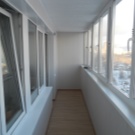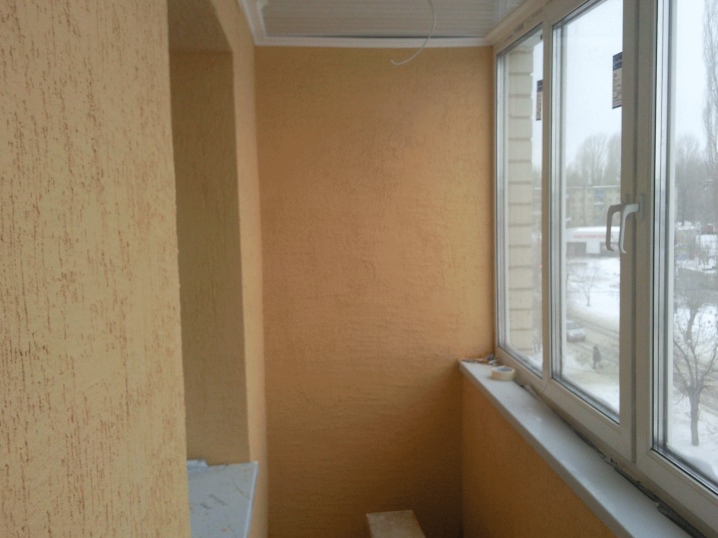Finishing a loggia with your own hands
Surely not everyone knows what the difference is between a balcony and a loggia. Balcony is a structure that protrudes beyond the wall and is usually located on the front of the building. It has three sides jutting out and a fence. The loggia has one open side, and the other three are closed and are parts of the room.
The squared apartment with a balcony is multiplied by a factor of 0.3 and added to the total squared apartment. In the case of a loggia, this coefficient is already equal to 0.5. It is necessary to take into account this important point, especially now, when the price per square meter of an apartment grows every year.
Balcony is more difficult to improve in many ways, this applies to glazing, insulation and finishing. Therefore, finishing the loggia with your own hands will require less effort from the owners of the apartment.
Finish
Why do we have to transform the loggia? During the day we look into this room or go in more than once and observe a dull and neglected view there — not verypleasant occupation. Another thing repaired, trimmed loggia, inscribed in the overall design of the apartment or adjacent room. There may be a greenhouse corner, a place of solitude for a coffee lover, for a schoolboy with a book, for a mother with a fashion magazine in her hands. The head of the family will be happy to enjoy the family idyll.
In order to decorate the loggia inside, it is necessary to prepare both materially and theoretically, and master at least a minimum of knowledge before starting work. When interior walls should be taken into account several parameters:
- what we want in the end result
- will it be warmed or stay cold
- financial costs (sometimes it comes first)
If you have correctly defined the future design and selected high-quality and preferably inexpensive material, then after finishing the loggia will become a welcome and permanent place to hang out for family members and guests.
Materials
Wall paneling is the most popular material for interior work. This board is made of wood of various breeds with a thorn-groove profile, 1.5 cm thick, 9 cm wide. Other sizes and types of carriages can be made to order (eurolining, block-house under a log). Lining has good working qualities and appearance.Environmentally friendly material with low thermal conductivity is well suited for many types of work and finishing.
But it should be noted and disadvantages:
- Mandatory application of protective compounds
- you can work only with glazed balconies, moisture and temperature extremes harm the material
- can fade in the sun
- not cheap
There is also a lining of plastic - siding. It successfully replaces wood in both interior and exterior. Siding can be of different colors and shades, finishing with its use does not depend on the glazing of the loggia, it does not fade in the sun. Its cost is lower than wooden lining.
PVC panels
Work on finishing with the use of these panels is as simple as with siding. Wide (25-30 cm) units quickly cover the working field. They are durable, resistant to external influences, and therefore suitable for both warm and cold loggias. Colors and shades are different, the cost is low, suitable for any option.
MDF panels
These are plates from the pressed wood fibers, covered with the PVC film under color of a tree. They are durable, good heat and sound insulators, aesthetically appealing, easy to install and inexpensive.But they have low mechanical strength, instability to moisture. Loggia should be glazed and insulated.
Drywall
The use of drywall significantly speeds up all the work due to the large size of the sheets. If the loggia is glazed and insulated, then this material will help to quickly and accurately finish the room. Finishing of sheets may require painting, wallpapering, application of decorative plaster. Usually use moisture resistant plasterboard. GKL sheet thickness - 9.5 mm or 12 mm.
Decorative plaster
Finishing with its use realizes interesting ideas, gives unusually bright effects.
Three different decorative plasters can be used to achieve the desired effect:
- Structural
- Textured
- Venetian
All of them are sold in finished form, but if you wish, you can prepare the compositions with your own hands. Let us dwell on the "Venetian" transparent plaster. This is a mixture of marble flour, seemingly transparent viscous mass in containers of 7-25 kg. It is applied on perfectly smooth surfaces in several layers, it can be tinted in any color. The application technology is not complicated, but rather voluminous, it allows to get the effect of marble coating of a variety of surfaces and shades.Such plaster is waterproof, eco-friendly, odorless, wear-resistant, able to dry quickly.
If the material and the overall design is selected, then you can begin work. We assume that the glazing has already been done, but it is desirable that the glass and double-glazed windows were removed from the frames of the windows to avoid any trouble. Finishing work on the floor is performed after the completion of work on the ceiling and walls.
So, we have window frames, a framework for hanging intermediate or finishing materials. We start directly finish.
Step-by-step instruction
The clapboard cladding work is simple, but it requires attention and patience.
Determine the required amount of material in square meters. We multiply the height of each section by the width, summarize and increase the resulting area by 15%. Choose conifers with a humidity not higher than 12%. We still need rails, corners, baseboards, film for waterproofing, sealant and fasteners. Tool: handsaw, drill, hammers, screwdrivers, including electrical, and levels, simple or laser.
If necessary, cover the wall with a film for waterproofing and make a crate of wood or metal profiles.Keeping a distance of about 50 cm between the slats, fasten them to the wall. The gaps are filled with insulation.
We start the trim with a corner, align the first board with the level and fasten it with a groove to the corner. We insert klyaymer and fasten it to the crate. The next board should groove tightly to connect with the ridge of the first and secured with a cleat, nailed to the crate. The position of each board is controlled by level. It is very convenient to have a laser level that allows you to quickly control the position of the board.
After all the boards are fixed, fill the slots with sealant, close the corners with the corners. Next, we process a protective solution such as “Avtotex”, which not only protects against rotting and bugs, but gives the surface of the skin an aesthetic look.
PVC paneling
This work does not require special training. The walls do not need to align, the assembly itself is quite fast. If necessary, disassembly will not be difficult.
Measure the length, width. Determine the right amount of material and increase it when ordering by 15%. We buy:
- PVC wall panels
- mounting rails
- fasteners and fasteners
- drill, screwdrivers (better electrovert), saw, screws
Fasten the slats to the wall at intervals of 50 cm. Cut off the excess with a saw. We measure, check the verticality and fix the corner profile with clips on the rail. The panel is mounted in the corner profile, laser control and fastening with clips. All the following panels are mounted in a similar way.
Places at the openings are closed with plastic corners. It is important to know that we have considered cases of fastening without loggia insulation. If there is insulation, the rails are mounted on top of thermal protection. Usually, a loggia enclosure is part of a wall with a window opening and there is no need for exterior decoration. In the case of fences in the form of a metal fence, work is being done to close the fence outside with impenetrable shields and PVC cladding. These jobs require special security measures.


































































